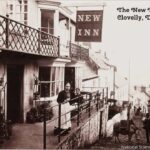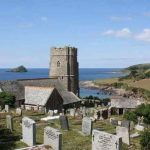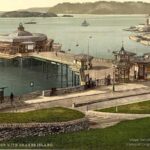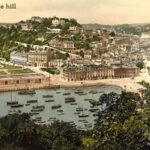Enjoy a glimpse of history through old images of Plymouth, the seaside city in Devon, England, UK.
Old Photos of Plymouth
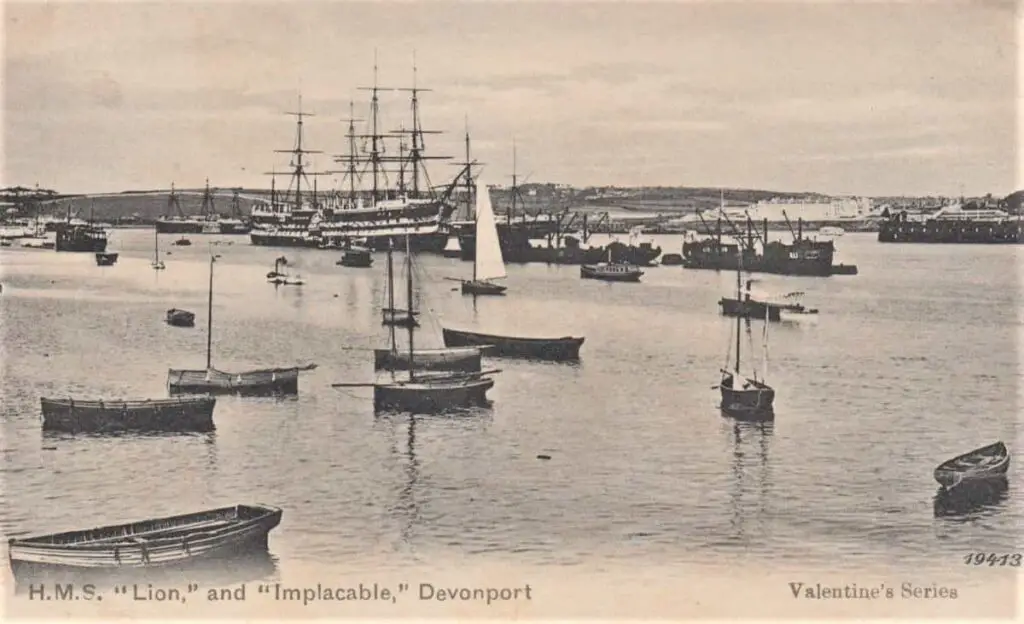
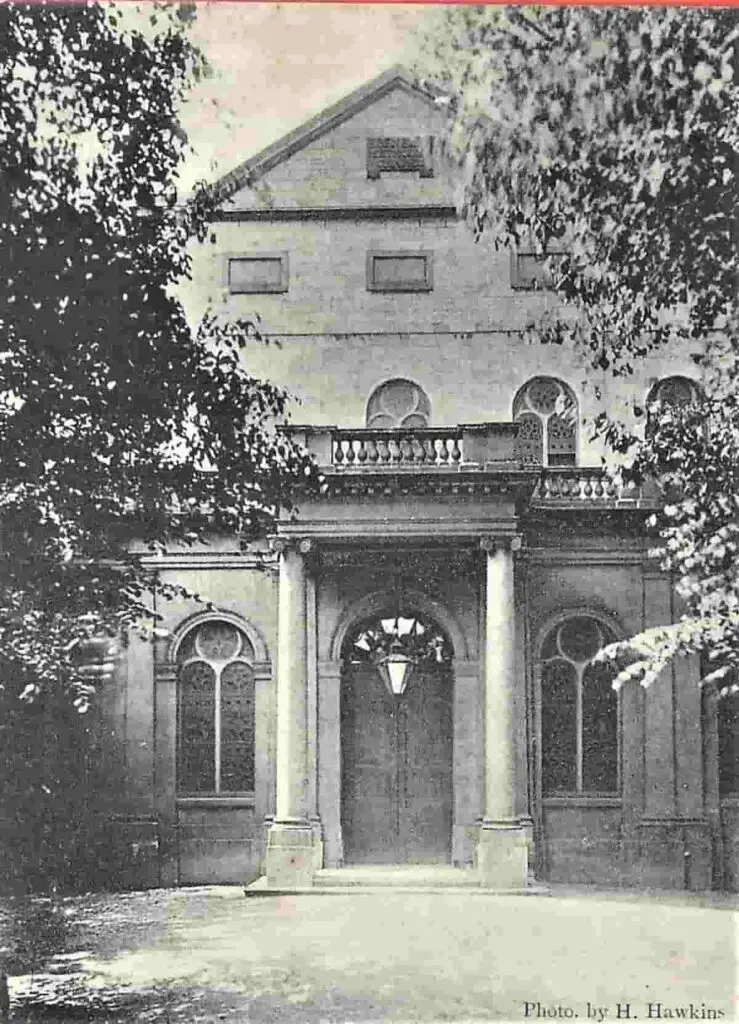
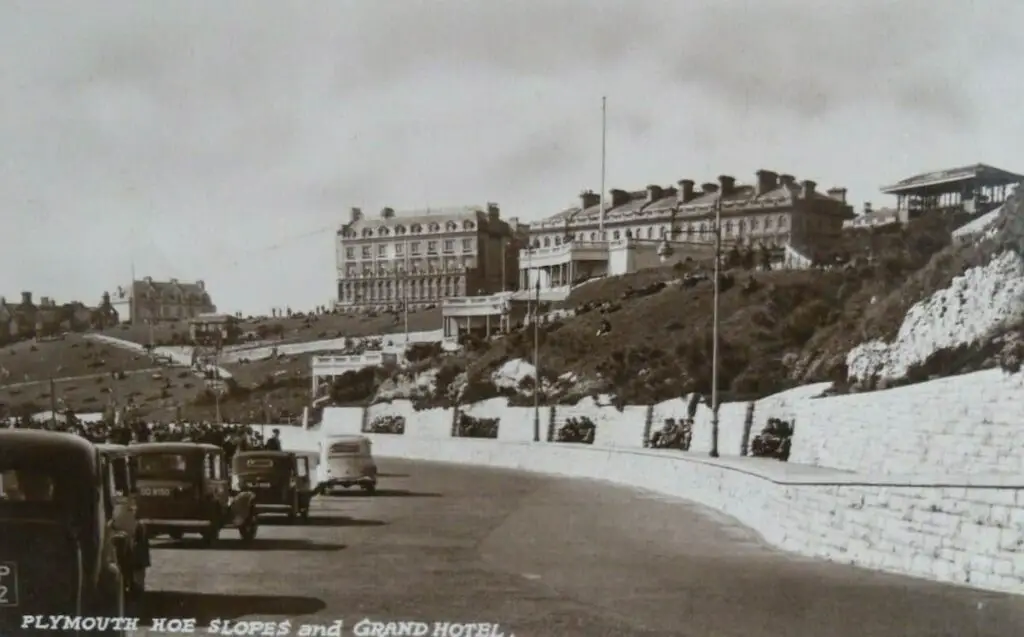
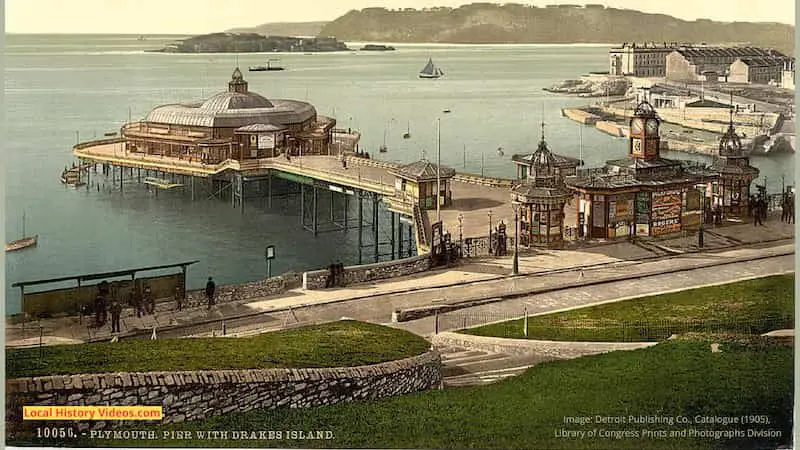
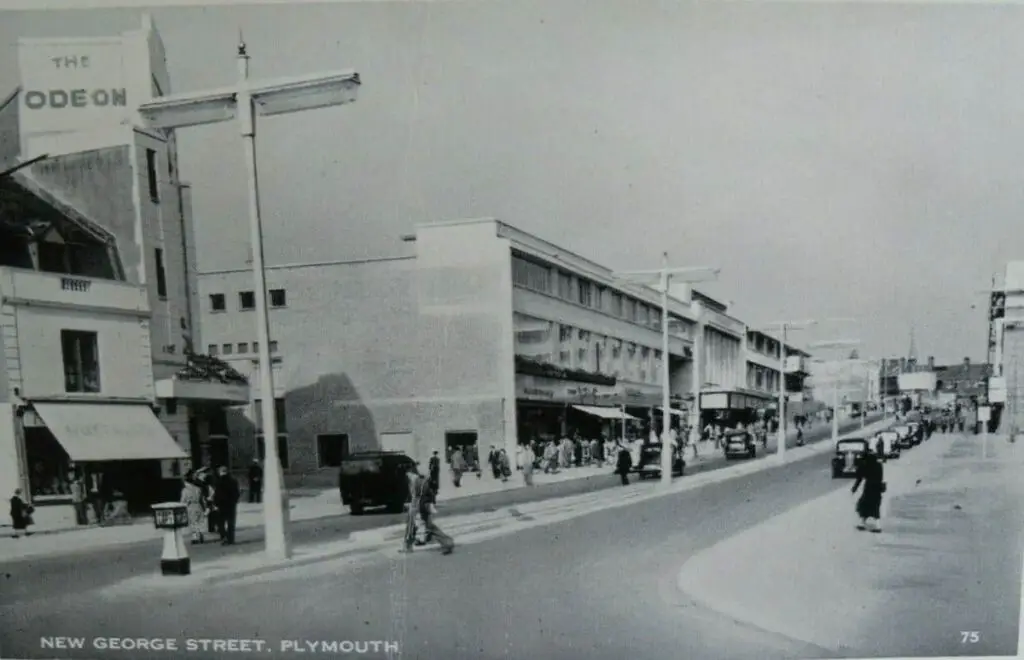
Plymouth Civic Week 1927
During Civic Week 1927, Lady Jellicoe inaugurated a new lifeboat. There was a posh garden party, and a cricket match.
Plymouth Civic Week (1927) – British Pathé on YouTube
1920s Carnival
This silent, black and white footage shows carnival antics at various locations. The best background views are behind the boats full of costumed people.
Plymouth Carnival (1920-1929) – British Pathé on YouTube
Bomb Damage 1941
During World War II, the Lufftwaffe dropped bombs on Plymouth on 59 occasions, killing 1,172 civilians, and injuring a further 4,448.
The air raids started on Saturday 6 July 1940, when three people died at North Prospect. Five bombing raids in 1941 reduced much of the city to rubble. Two attacks in May 1944 marked the end of this terrifying ordeal.
In 1941, families evacuated their children out to live with relatives and complete strangers far from the city. During air raids, large sections of the remaining population – which had dropped to 220,000 to as low as 127,000 people – would flee to the countryside in lorries.
The royal dockyards at HMNB Devonport remained open, despite being the target of the air attacks.
This newsreel records the visit of Prime Minister Winston Churchill to the ruins of Plymouth in the deadliest year, 1941.
Churchill Visits Plymouth (1941) – British Pathé on YouTube
Children Evacuated 1941
Some of the children in this silent footage were very young, but even the children approaching their teenage years must have been very nervous about what was going to happen to them. Most evacuees had no idea where they would live, who with, or for how long.
It’s interesting that they arrive at the railway station by bus, accompanied by a small number of organisesers but not their parents. Clearly their parents were not allowed to be there, which makes sense for organisational reasons and perhaps made for a calmer departure.
All they had was one bag, and a label attached to them to identify them, before leaving on a steam train.
Children Evacuated From Plymouth (1941) – British Pathé on YouTube
Police Memorial 1946
On 20th October 1946, a dedication service was held in St. Andrews Church for the members of the Plymouth City Police Force who died in the city of overseas during the Second World War, 1930-1945. The church had no roof or windows, and sat in an area clearly badly damaged by the bombing raids.
The Bishop of Plymouth then unveiled the memorial listing the fallen men. The Imperial War Museum has a photo of this memorial if you wish to see the names and police unit.
Plymouth City Police Memorial (1946) – British Pathé on YouTube
Plymouth Reconstruction 1947
This newsreel from 1947 includes footage of bomb sites, rows of tiny pre-fabricated houses packed closely together, pre-fabricated shops, students from Czechoslovakia working on the building sites without any safety gear whatsoever (even their shoes look flimsy), and new streets under construction.
The Mayor puts in the foundation stone to a new radio factory, which will provide employment to several hundred local men and women.
Bombed Plymouth, England rebuilds homes and industries following WWII (1947) – British Pathé on YouTube
Plymouth in the 1964
Many different locations, events, cars, buses, and people appear in this digitised 8 cine film recorded in 1964.
Plymouth, Devon. 1964 – SlhKernow on YouTube
Plymouth in 1986
One Saturday during December 1986, this home movie was made during a drive through the city. It includes many shops, restaurants, people, streets and cars along the way, at a time when New George Street and New Cornwall Street were yet to be pedestrianised.
Xmas Movie Plymouth City Centre 1986 – Nick Colbourne on YouTube
Plymouth in 1997
This home movie was recorded on a grey day in 1992. Dingles, Freemans, Stead & Simpson, Debenhams and Woolworths are some of the shops open in the pedestrianised city centre. There are also views of the many other streets and buildings, with people going about their daily lives.
Plymouth City Centre 1992 – John Skeldon on YouTube
Local Buses
This DVD trailer shows buses in 1997, along with a few glimpses of local buildings and businesses, and occasionally a pedestrian walking by.
PLYMOUTH BUSES 1997 DEVON – DaveSpencer32 on YouTube
Historic Book
Extract from
“The Plymouth and Devonport guide”
by Henry Edmund Carrington
Published 1828
Pages 37-41
PLYMOUTH is a town of considerable antiquity, but it was principally inhabited by fishermen till the reign of Henry II. In the time of the Saxons, it was called Tameorwerth; after the Conquest, it acquired the name of South-town or Sutton. In the reign of Edward I., it was denominated Sutton-Prior and Sutton-Valletort, the north part of the town being situated on the lands of the Prior of Plympton, and the south on the estate of the Valletorts; but in the time of Henry VI., these names were relinquished for the more appropriate name of Plymouth.
Plymouth is distant 218 miles from London and stands in the parishes of Charles and St. Andrew. It is a borough town, sending two members to parliament. Its population amounts to nearly 24,000. Many of the streets are narrow and irregular, but improvements are daily taking place, and elegant edifices, both public and private, are springing up in every direction. The mayor is the chief magistrate; he is assisted in his duties by the justice (the mayor for the preceding year) and two senior aldermen. They sit on Mondays and Thursdays at the Guildhall for the purpose of determining causes of inferior importance; but the Courts of Quarter Sessions are competent to try all offenses not involving capital punishment, and to decide all civil causes arising within the limits of the borough.
The town contains two parish churches, St. Andrew’s and Charles’, the former of which is of venerable antiquity. It has been lately repaired and embellished at a great expense. It contains a fine organ and some very curious monuments. Charles’ Church was built in the reign of Charles II. The interior is spacious but not handsome. The spire is of Dartmoor granite, and being light and airy, forms a pleasing finish to the building. Besides these places of worship, we have to notice St. Andrew’s Chapel of Ease and the various dissenting meeting-houses in the town, among which are the Presbyterian Chapel in Batter Street; the New Tabernacle (Calvinist) in Norley-lane; the Ebenezer Methodist Chapel at the head of Old-town-Street; the Unitarian Chapel, Broad-Street; the Old Tabernacle, Britonside; the Friends’ Meeting-house in Broad Street; the Baptist Chapels in Norley-lane and Broad Street, etc. The Jews’ Synagogue is in Catherine Street.
The Market is very convenient and spacious, occupying nearly three acres of land. It is well supplied with commodities of all kinds which are sold at a cheap rate. The principal entrances are in Cornwall-Street, East-Street, and Drake Street. The Plymouth Fairs are held in the Market-place. The tolls are the property of the corporation.
The chief inns are Whiddon’s Royal Hotel, George-Street; the Commercial Inn, Old Town Street; the King’s Arms, Britonside; and the Globe Inn, Bedford-Street. Several stage coaches leave the town for London every day. The Erin steam-packet runs from Plymouth to London and Belfast, which voyage she accomplishes in a very short period of time. The Brunswick steam packet runs between Plymouth and Portsmouth twice a week, taking goods and passengers. The hackney coach stand is principally in Old-town Street, but “dillies,” as they are provincially termed, are stationed in various other parts of the town. These vehicles are generally employed in conveying passengers from one town to the other, but they are frequently hired for excursions into the country.
Plymouth is abundantly supplied with excellent water, by a fine leat, which was first brought into the town in the reign of Elizabeth, at the sole expense of the renowned and patriotic circumnavigator of the world, Sir Francis Drake. This stream is diverted from the river Mew, just above Sheepstor bridge, on the skirts of Dartmoor, and winds a circuitous route of twenty-four miles. The water is distributed from a reservoir at the head of the town through the principal streets and into the houses of such of the inhabitants as are willing to pay for this accommodation. The revenue resulting from the leat belongs to the mayor and corporation.
The Public Charities of Plymouth are very numerous. The principal are the Dispensary, the Eye Infirmary, the Lying-in Charity, the Misericordia, the Merchants’ Hospital, the Female Benevolent Society, the Blanket Society, the Corpus Christi Society, the Provident Society, Charles’ Alms Houses, and Jory’s Alms Houses. The Schools for Poor Children are Hele’s Charity, Lanyon’s Charity, Orphan’s Aid, Grey School, Lady Rogers’ School, Household of Faith, School of Industry, the Public Subscription School in Old-town Street; & c. The religious societies are the Auxiliary Bible Society, the Ladies’ Bible Association, the Auxiliary Society for promoting Christian Knowledge among the Jews, the Religious Tract Society, the Peace Society, Society for promoting Christian Knowledge, the Bethel Union, and the Auxiliary Missionary Societies connected with many of the dissenting chapels.
The principal literary institution is the Atheneum, which owes its origin to the efforts of Henry Woollcombe, Esq. and some other gentlemen who were disposed to co-operate in the measure. The building of the Society stands near the Theatre at the end of George-Street.
Pages 43-47
The Public Library, connected with which is a News-Room, stands in Cornwall Street. The front of the building is simply elegant, without windows, as the different apartments of the interior are lighted by glass cupolas in the roof. The entrance from the street is through a vestibule, on either side of which are the committee and news-rooms. At the end of the vestibule is the library, containing a large and valuable collection of well-selected books. Each of the four sides of the room is surmounted by a beautiful segment arch, richly ornamented, and supporting the roof which terminates in a light and elegant dome, resting on fluted pillars.
The Plymouth Mechanics’ Institute was formed in the early part of 1826. This Society originated among the mechanics of this town, and its views were much forwarded by a generous donation of £100 from C. Greaves, Esq. Other subscriptions with gifts and loans of books from many liberal-minded gentlemen have contributed towards placing this Institution on a permanent basis.
The Theatre and Hotel. This massive and noble pile of building stands at the western end of George Street. It was erected in 1811 by the Corporation of Plymouth, whose property it still is. The north front is 275 feet in length. In the centre is a magnificent portico, seventy feet wide, consisting of eight Ionic columns, designed after the purest Greek models. On the eastern side of the building is a smaller portico about fifty-nine feet wide. The columns in each portico measure three feet six inches in diameter. The east wing of the building is occupied by the Royal Hotel, which is handsomely fitted up, containing a fine ballroom and many other spacious apartments.
The western wing contains the Theatre. This place of amusement is open during the winter season. Its interior embellishments and scenery are very beautiful; indeed, no expense has been spared to render it one of the most elegant theatres outside of London. The performers who appear on this stage are generally of very respectable abilities.
The Commerce of Plymouth is not as considerable as its population and extent would seem to argue. It carries on, however, a good coasting trade, and its maritime intercourse with foreign nations is by no means trifling. The harbour of Catwater affords good anchorage for shipping. It is well sheltered from the southern gales by the peninsula of Mount Batten.
The principal commercial wharfs of Plymouth are in Sutton Pool, a commodious basin situated almost within the town. At its entrance from Catwater are two piers of solid masonry, between which is a passage about ninety feet wide for the admission of ships. Sutton Pool is the rendezvous of the trawlers or Plymouth fishing vessels that supply the town and neighborhood with an abundance of excellent fish.
The Exchange, a place of general resort for the merchants and traders of Plymouth and its neighborhood, stands in Woolster Street and was built in 1813. It is conveniently situated near the Custom House, the quays, and the principal mercantile warehouses.
A spacious piazza surrounds an open area, from which a massive staircase of granite leads to apartments appropriated to the various objects of the Institution.
The great room for sales, meetings, and other business is well adapted for such purposes; an adjoining corridor affords access to the Reading-room, Chamber of Commerce, Marine Insurance Office, the Office of the Oil Gas Company, the Office of the Steam Packet Company, etc.
The Guildhall is a building of no pretensions to architectural beauty, situated in Whimple Street. The principal hall contains some old portraits, and at the east end is a fine picture of our present majesty, painted while he was Prince Regent by Hopner.
At the Guildhall, in addition to affairs immediately connected with the borough, almost all business of a public nature is transacted.
The Plymouth and Dartmoor Railway was commenced in 1819 under the sanction of an act of parliament procured for that purpose. It leads from Sutton Pool to Kingstor near Walkhampton, a distance, including the windings of the road, of about twenty-four miles.
The property of the Railway is vested in a company of shareholders and is at present employed in transporting granite from the moor. The carts used for this purpose carry out lime and other manure, coals, etc.
Plymouth has an annual Regatta at which boats and yachts of different sizes contend for valuable prizes. This grand national amusement takes place in the Sound, which on such occasions wears a very beautiful and enlivening aspect. Thousands of spectators crowd the Hoe and the neighbouring shores, while an immense number of pleasure boats, filled with gaily dressed gazers, make the waters of the Sound “instinct with life and motion.”
The Regatta formerly lasted two days, but the races are now decided in one day.
The Hoe, which may be called “the lungs” of Plymouth, lies on the south of the town. It occupies the whole line of the Sound, facing the south, and is an open eminence devoid of trees or shrubs, but overlaid with a velvet green sward; in the centre of which is a wide gravelled path, used as a promenade by the inhabitants of Plymouth, who have free access to all parts of this delightful spot.
Its height being equal to that of any ground in the immediate neighbourhood, it commands an extensive view and overlooks a vast range of populous communities, including Plymouth, Devonport, Stonehouse, and Stoke, which alone are reported to contain seventy thousand souls.
In the cool evening of a sultry day, the inhabitants of all ranks and conditions may be seen crowding to the Hoe to inhale the refreshing sea breezes, and there, on a plain surface half a mile long, they may escape the lassitude generated by cares and a contracted atmosphere, or, descending by a gentle declivity to the shore, receive that quiet and solitary satisfaction which is always found in the neighbourhood of the great deep when its waters are still.
More about Devon
- Clovelly, Devon: History in Old ImagesEnjoy a glimpse of history through old images of Clovelly, in Devon, England, UK.
- Old Images of Devon, EnglandGlimpse history through old images of Devon, England.
- Old Images of Plymouth, UKEnjoy a glimpse of history through old images of Plymouth, the seaside city in Devon, England, UK. Old Photos of Plymouth Plymouth Civic Week 1927 During Civic Week 1927, Lady Jellicoe inaugurated a new lifeboat. There was a posh garden party, and a cricket match. Plymouth Civic Week (1927) – British Pathé on YouTube 1920s… Read more: Old Images of Plymouth, UK
- Old Images of Torquay, Devon: Historic Photos & FilmEnjoy a glimpse of history through fascinating old images of Torquay, Devon, England, UK.
- Dr Thomas Macnamara, Minister of LabourFind out more about the Canadian born British politician who became Minister of Labour to Lloyd George, Dr Thomas James MacNamara.
- Old Images of Exeter, DevonGlimpse the past through old images of Exeter, in the beautiful English county of Devon.
- Devon: Local History ResourcesThis page introduced some of the pages and resources available to everyone interested in the history of Devon and its settlements.

